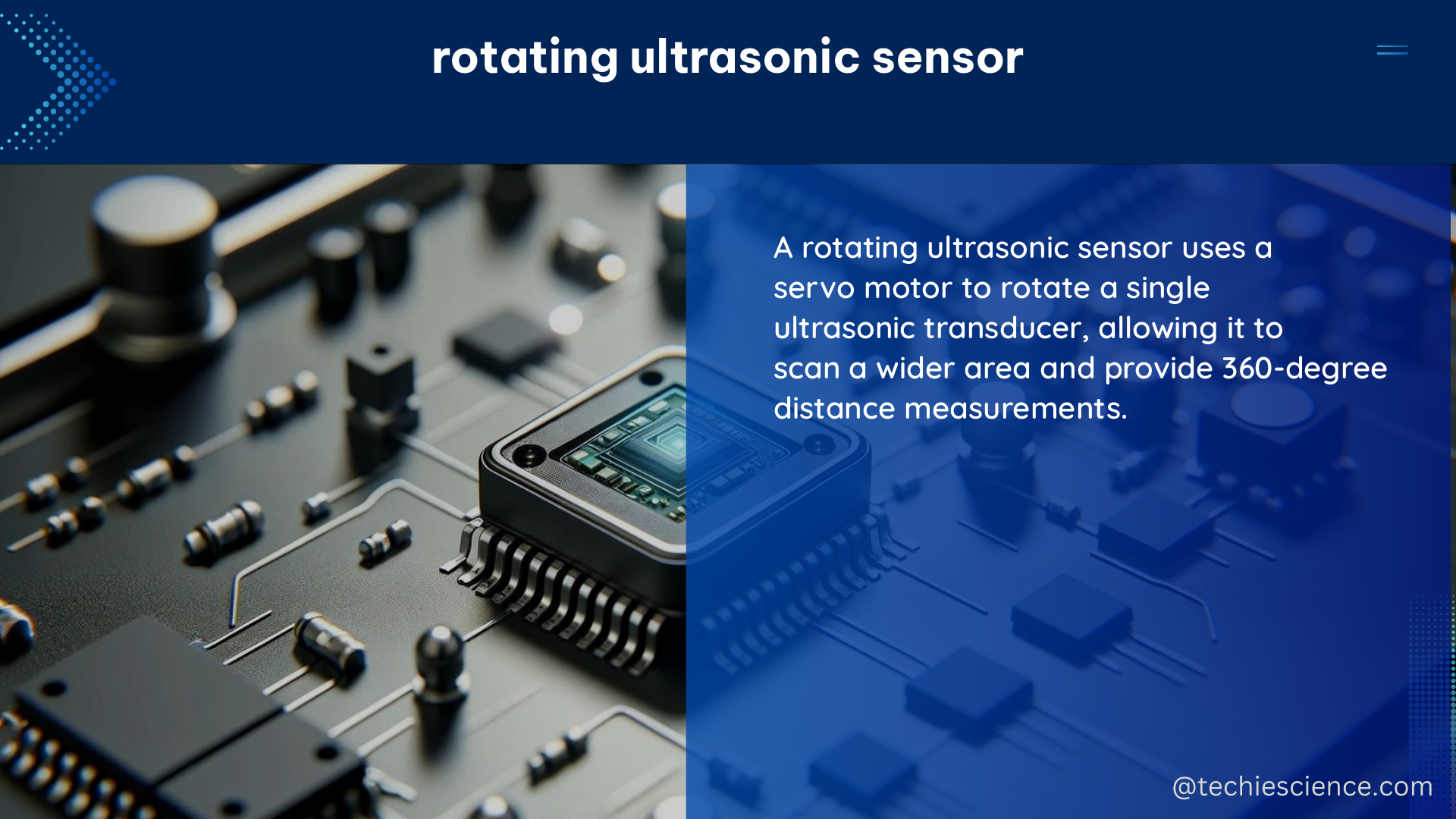Rotating ultrasonic sensors are versatile devices that use ultrasonic waves to detect and measure the distance to objects in their environment. These sensors consist of a transducer that generates ultrasonic waves and a rotating mechanism that allows the transducer to scan the surroundings in a 360-degree radius. By measuring the time it takes for the ultrasonic waves to travel to an object and reflect back, these sensors can accurately calculate the distance to the object.
Understanding the Technical Specifications
When it comes to rotating ultrasonic sensors, there are several key technical specifications to consider:
Measurement Range
The measurement range is the maximum and minimum distance that the sensor can accurately measure. For example, the MaxBotix LV-MaxSonar-EZ4 has a measurement range of 0.125 to 7.62 meters (0.41 to 25 feet). This wide range allows the sensor to be used in a variety of applications, from small-scale robotics to large-scale industrial automation.
Angular Resolution
The angular resolution is the smallest angle that the sensor can distinguish between two objects. The LV-MaxSonar-EZ4, for instance, has an angular resolution of 0.17 degrees, which means it can detect and differentiate between objects that are separated by as little as 0.17 degrees. This high level of precision is crucial for applications that require accurate object detection and tracking.
Accuracy
Accuracy is typically measured as the percentage of measurements that fall within a certain tolerance range. The LV-MaxSonar-EZ4 has an accuracy of ±1% of the measured distance, which means that for a distance of 5 meters, the sensor’s measurement will be within 5 ± 0.05 meters. This high level of accuracy is essential for applications that require precise distance measurements, such as industrial automation and autonomous vehicles.
Response Time
The response time is the time it takes for the sensor to detect an object and measure its distance. The LV-MaxSonar-EZ4 has a response time of 45 microseconds, which is incredibly fast and allows the sensor to quickly detect and respond to changes in its environment.
Power Consumption
Power consumption is an important consideration, especially for battery-powered applications. The LV-MaxSonar-EZ4 consumes 15 milliwatts of power when idle and 30 milliwatts when active, making it a relatively low-power sensor that can be used in a variety of applications without draining the power source.
Applications of Rotating Ultrasonic Sensors

Rotating ultrasonic sensors have a wide range of applications, including:
- Robotics: These sensors can be used in autonomous robots to detect and avoid obstacles, as well as to map their surroundings.
- Automation: Rotating ultrasonic sensors can be used in industrial automation to measure the distance between objects on a production line, ensuring accurate positioning and alignment.
- Transportation: Autonomous vehicles can use rotating ultrasonic sensors to detect pedestrians, obstacles, and other vehicles, improving safety and navigation.
- Security and Surveillance: Rotating ultrasonic sensors can be used in security systems to detect intruders and monitor the perimeter of a facility.
- Environmental Monitoring: These sensors can be used to measure water levels, detect flooding, and monitor other environmental conditions.
Selecting the Right Rotating Ultrasonic Sensor
When choosing a rotating ultrasonic sensor for your application, it’s important to consider the specific requirements of your project. Some key factors to consider include:
- Measurement Range: Ensure that the sensor’s measurement range is suitable for your application.
- Angular Resolution: Determine the level of precision required for your application and select a sensor with the appropriate angular resolution.
- Accuracy: Choose a sensor with the desired level of accuracy, based on the requirements of your project.
- Response Time: If your application requires rapid detection and response, select a sensor with a fast response time.
- Power Consumption: Consider the power requirements of your application and choose a sensor that fits within your power budget.
By carefully evaluating these technical specifications and selecting the right rotating ultrasonic sensor for your needs, you can ensure that your project is successful and meets all of its requirements.
Conclusion
Rotating ultrasonic sensors are powerful and versatile devices that can be used in a wide range of applications, from robotics and automation to transportation and environmental monitoring. By understanding the key technical specifications of these sensors, including measurement range, angular resolution, accuracy, response time, and power consumption, you can select the right sensor for your project and ensure that it performs to your expectations.
References
- MaxBotix, Inc. (2022). LV-MaxSonar-EZ4 Ultrasonic Sensor. Retrieved from https://www.maxbotix.com/Ultrasonic_Sensors/LV-MaxSonar-EZ4.html
- Federal Register. (2014). Federal Motor Vehicle Safety Standards; Rear Visibility. Retrieved from https://www.federalregister.gov/documents/2014/04/07/2014-07469/federal-motor-vehicle-safety-standards-rear-visibility
- Wang, X., et al. (2011). Sensing and Sensor Fundamentals. Springer Science & Business Media.

The lambdageeks.com Core SME Team is a group of experienced subject matter experts from diverse scientific and technical fields including Physics, Chemistry, Technology,Electronics & Electrical Engineering, Automotive, Mechanical Engineering. Our team collaborates to create high-quality, well-researched articles on a wide range of science and technology topics for the lambdageeks.com website.
All Our Senior SME are having more than 7 Years of experience in the respective fields . They are either Working Industry Professionals or assocaited With different Universities. Refer Our Authors Page to get to know About our Core SMEs.